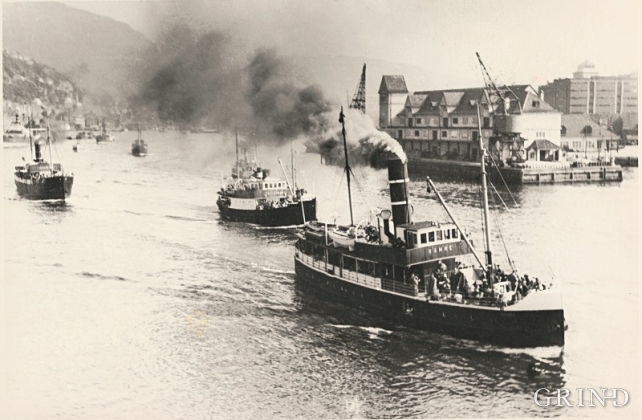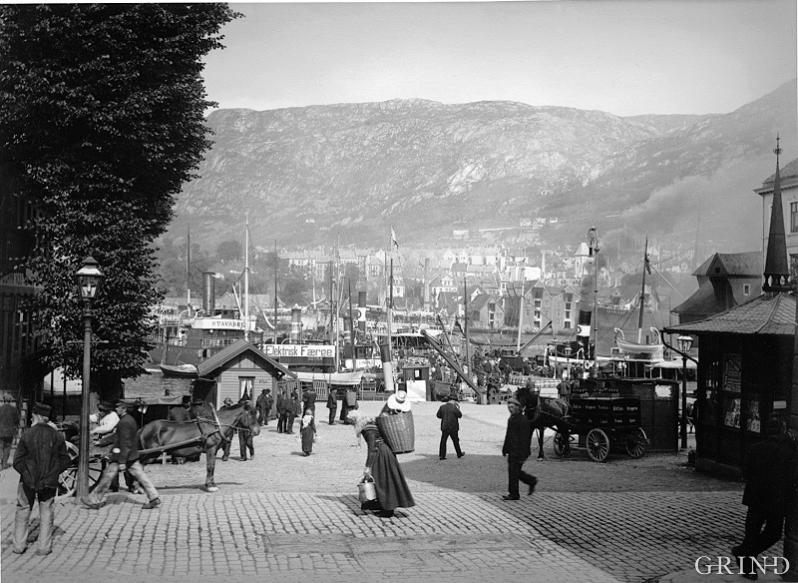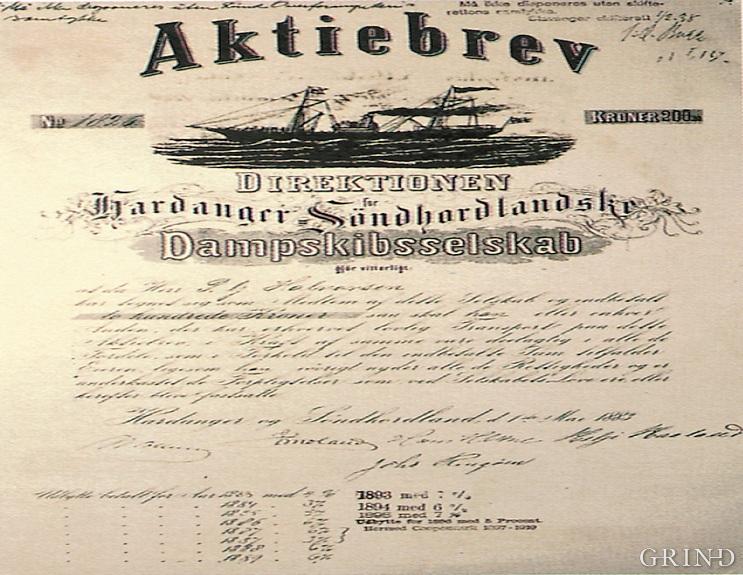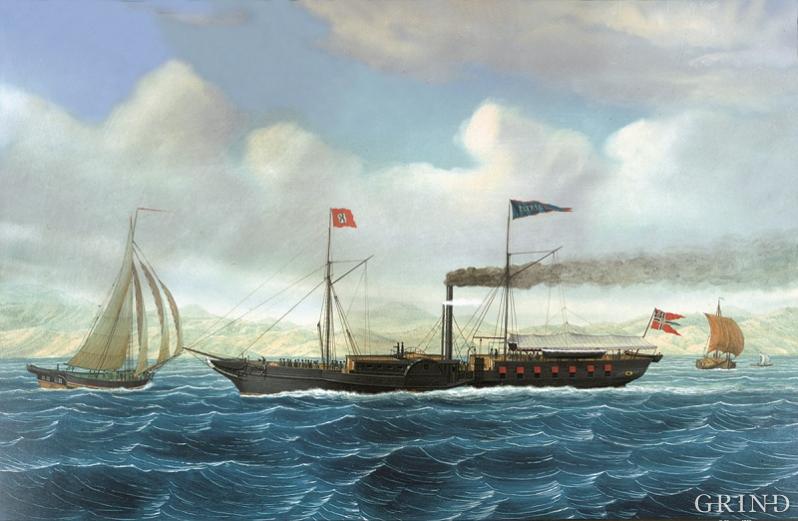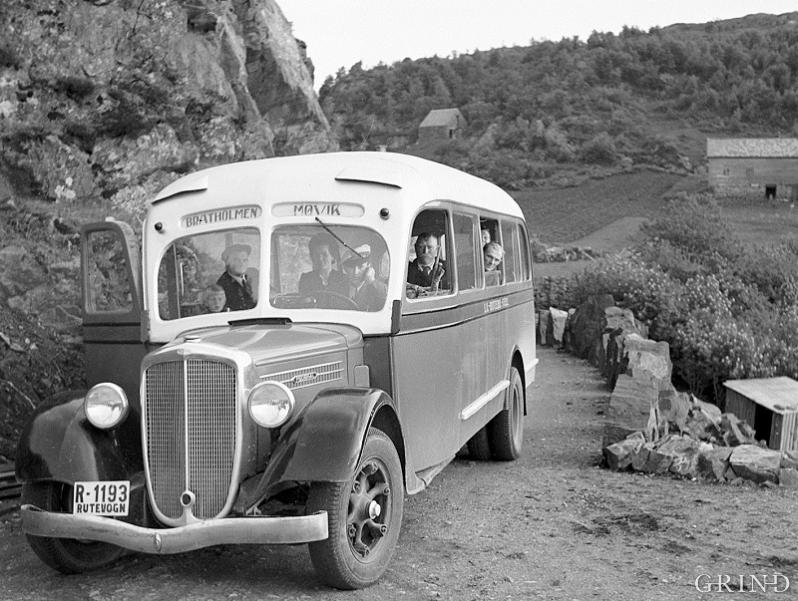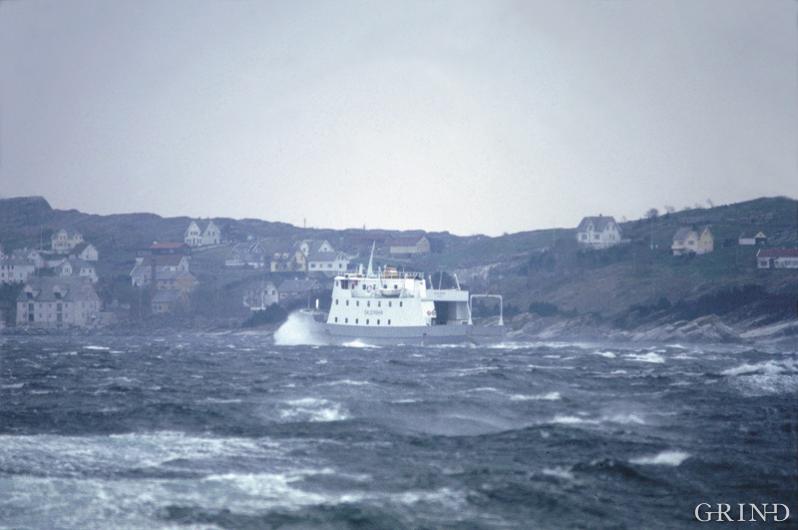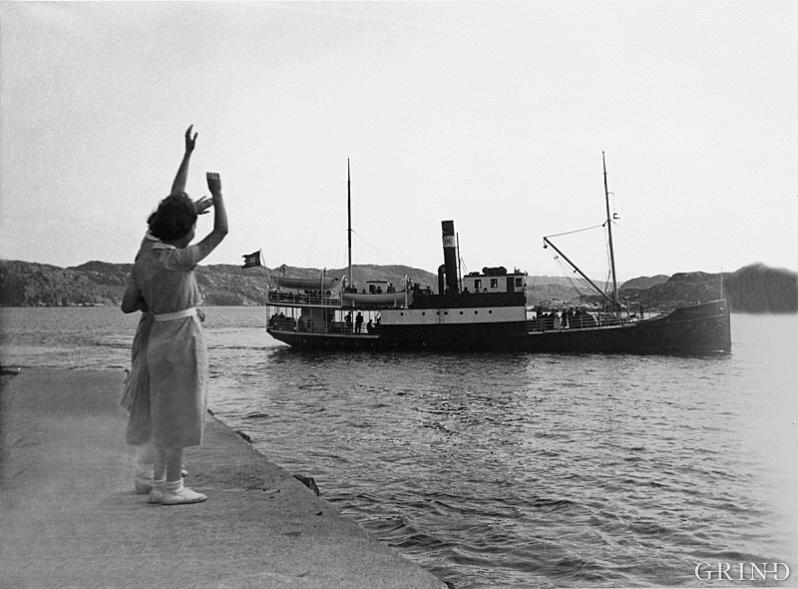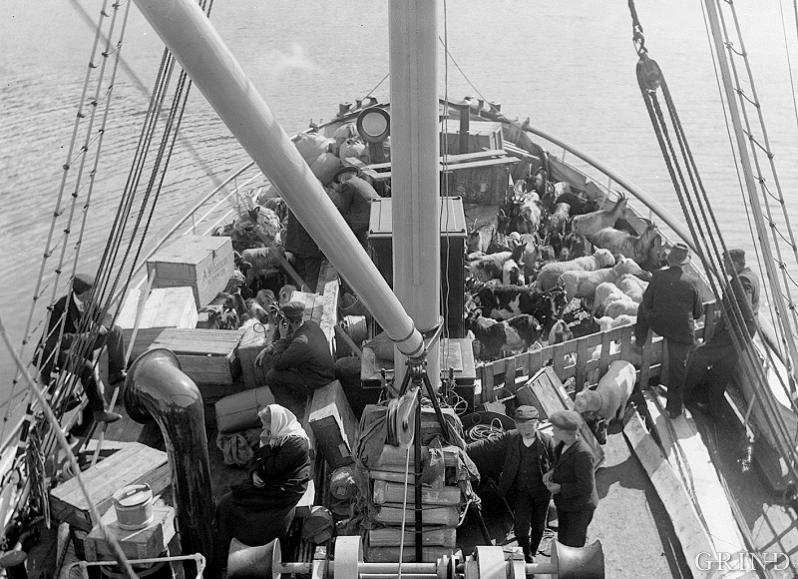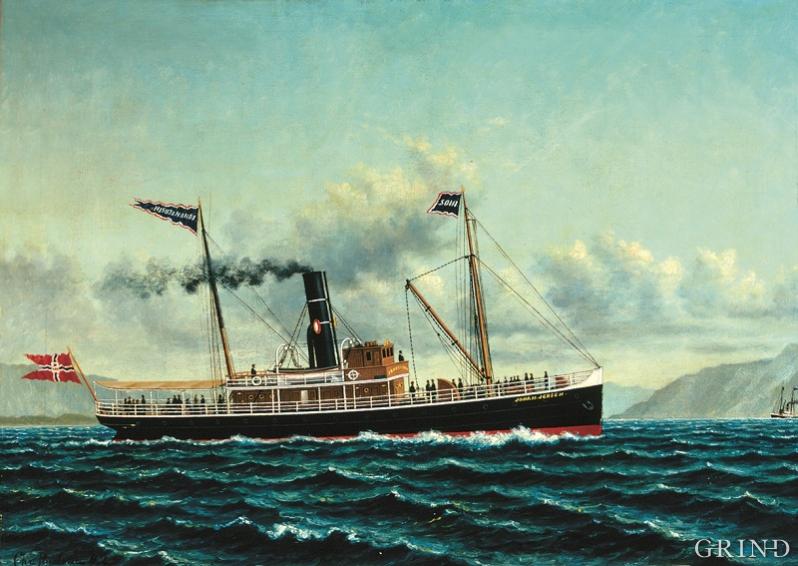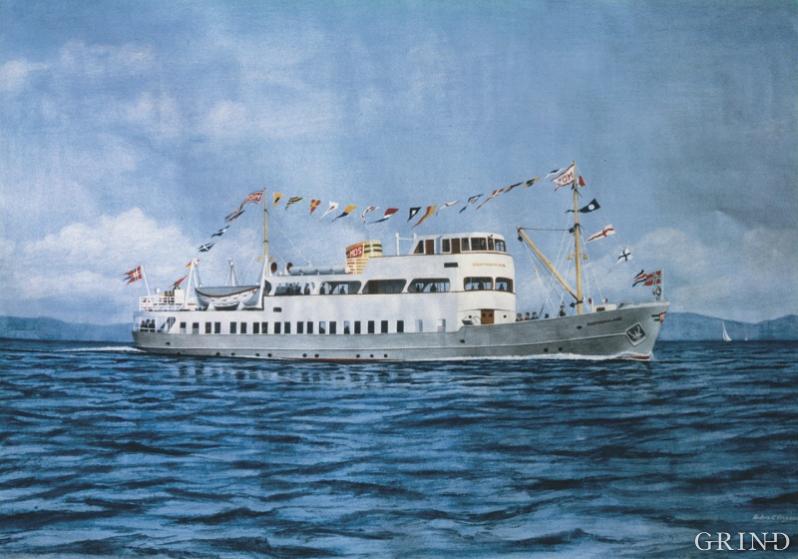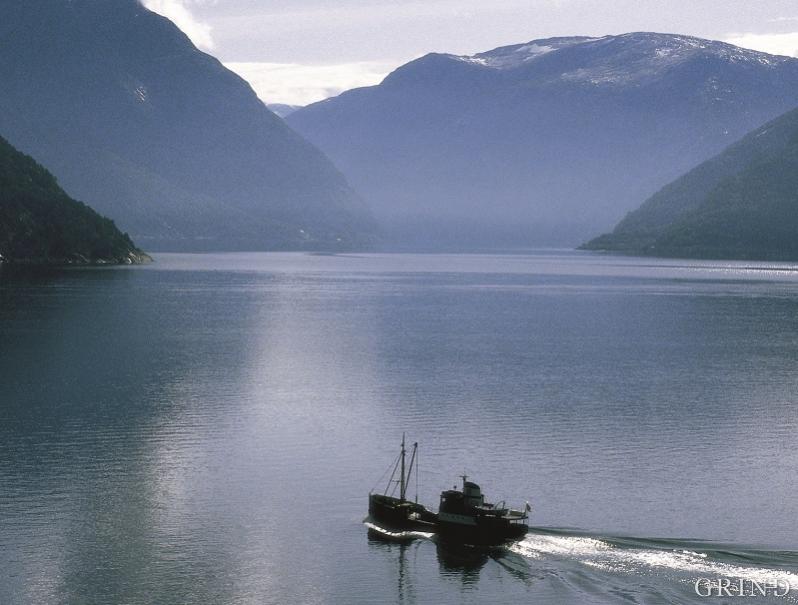Published: 19.05.2009 | Author: Bård Kolltveit, Erling Virkesdal, Anders K. Engevik
Fjordabåtane går ut frå Vågen laurdag ettermiddag; eit vanleg syn til fram i 1960-åra (Norvin, eigar: Stein Thowsens billedsamling).
THE FJORD STEAMER BOAT
“On the quay at Bergen, there lay a boat,
So beautifully polished that it shone,
With fine masts and a funnel with tone.
And many sorts of goods she sheltered.
There comes the steamer, the old steamer
Put on your wooden clogs and run.
There comes the steamer, the old steamer.
Ding-a-ling, ding-a-long”
Ragnvald Hammer: Dar kjem dampen
This nostalgic and slightly wistful song about the old steamship, the workhorse of west Norway’s transport system since the end of the 19th century gives us a compelling glimpse into a form of culture which disappeared in the communications revolution in post-war years. The song was written when DS OSTER, one of the last fjord boats trafficking Nordhordland, was taken out of operation at the end of the 1950s. Then an epoch came to an end: an epoch of fjord boats lined up along the Bryggen and Strandkaien, laden with agricultural products, goods from the city, country folk and townsfolk. OSTER, HAUS, HAMRE, JOHAN JENSEN, ALVERSUND, MELANDDROTT, ØYGAR, VØRINGEN, STORD and many others. Every Norwegian coastal town had its local shipping fleet. But none of them could match the armada which set off every afternoon from Vågen in Bergen. And out in the country districts the city culture and the rural culture met together on the quay and created a concentrated street life when the steamship came alongside to load and unload.
City companies in rural shipping
The tales of shipping traffic in Hordaland is no Sunday school story. Conflict and competition between town and country, between rural areas themselves and between different transport companies made their mark from the very beginning. The run-up came in the middle of the 1850s when the owners of three paddle steamers tried for a time to vanquish each other on the route between Sogn and Hardanger: PATRIOT, BJØRGVIN AND HORDALAND.
It was only in 1861 that steamship traffic between Bergen and the surrounding district took an organised form. In accordance with a Parliamentary resolution to transfer coastal traffic from the State to private companies, supported by the State, the county council in Northern Bergenhus (Sogn og Fjordane) resolved in 1856 to establish a county shipping company. Behind this establishment lay the fear that a private company, governed by capital from the city would take more account of the interests of the merchants in Bergen than those of the country districts. In Southern Bergenhus (Hordaland), however a similar measure failed due to internal differences within the district. Instead the County Government got an agreement between the state and the ship-builder Annanias Dekke for a route between Bergen and Odda. The route was opened in 1861 with the steamship VØRINGEN. In 1864 this route was extended to Sunnhordland. And so the basis was laid for what later developed into one of the big transport companies in the region.
The rural folk take over
Bergen merchants were the pioneers in building up steamship traffic. Several agricultural merchants invested money in local steamship transport so as to secure the supply of agricultural goods. The first Bergen company providing local transport, Dampbaadelaget (The Steamship Company), was established in the autumn of 1865. The company received support for the transport of mail from the Marine and Post Ministry.
At the beginning the Steamship Company served the areas in the vicinity of Bergen. The route network was extended gradually until it finally took in parts of Nordhordland, Midthordland and Sunnhordland. The rural folk soon realised the advantages in fetching and sending goods with the boat as the need arose, instead of a couple of times a year, as they had done for centuries, in the time of the rowing boats and sailing ships. But discontent with the boat service soon emerged. In the rural areas many folk thought that more concern was paid to the needs of the merchants in Bergen than to the people in the local district.
In the second half of the 1860s this discontent generated enough power and capital for a district company to be established. Periods of prosperity brought in more money, interest in investment and greater self-awareness. The rural districts backed up their own company. The steamship BJØRNEN started a service to the settlements in Midthordland in 1866 and HARDANGEREN to Hardanger in 1869. Det Nordhordlandske Dampskibsselskab bought the steamship ARNE and put it into service in Nordhordland in 1871. The year after the Søndhordlandske Dampskibsselskab was a reality. Throughout the 1870s the competition between the city and the rural companies became increasingly tough. The boats sailed in each other’s wakes, literally speaking. Even although the travellers themselves could enjoy cheap freight rates because of this rivalry, it could not last. The competition created more harm than good.
Plans for a major company dominated by town interests to serve both Northern and Southern Berghus led to the Hardanger Company joining up with the Søndhordlandske Dampskibsselskab in 1880 to become the Hardanger Søndhordlandske Dampskibsselskab (HSD). In the same year the Lindaas-Masfjordens Dampskibsselskab was established as a result of discontent with the existing service system. The discontent was especially directed at the fact that the farmers did not get the agricultural goods, and especially milk, delivered fresh enough to the market in Bergen and to the best possible price. The company existed until 1951. Then it joined up with the Alversund and Manger Dampskibsselskab to become the Bergen-Nordhordland Trafikklag (Transport Company).
The two competing steamship companies on Osterøy, Osterøens Dampskibsselskab and the Ole Bull Dampskibsselskab combined forces in 1891. Then they went together and established Indre Nordhordland Dambåtlag (Inner Nordhordland Steamship Company) (INDL), a company which stood on its own feet until it was merged with the Bergen-Nordhordland Trafikklag (BNT) in 1974 to become the Bergen Nordhordland Rutelag (Transport Service) (BNR). Many small competing transport services with their origins in Bergen were thus replaced by rural companies which amalgamated into a few big companies to serve bigger, limited districts. The developments in those years laid the foundations for what is still today’s traffic pattern.
The golden age of steam
Thus we see that sea transport has largely been unchanged in Hordaland County from the 1880s and for about 50 years onwards. This period was the golden age of the fjord vessel. The few roads which existed linked rural settlements with the steamship quays. There were seldom roads between the settlements. All traffic and transport was conducted by sea.
As the settlements came to be linked up by a steamship network, demands arose for roads to the sea. A number of rural roads and quays were built at the end of the 19th century, and this created a new social gathering point in the coastal settlements, the general store at the quay and boat house with a wind vane on the gable.
Most of the local boats came in the period 1890-1914. They varied in size and standard. Ships serving long, main routes to district centres were around 500 registered tonnes, whilst the smaller steamships in local routes around Bergen were only about one tenth of this size. Despite the differences in size they had many similarities. Two backward leaning masts, a pronounced ship’s bridge amidships, a funnel and a lifeboat on each side. Below the deck in front of the cargo hold was a poky little area for those travelling second class.
Here it was often so full that many passengers had to make do with a place on the deck together with milk churns, materials and breadboxes, or they had to go into the cargo hold with the cattle, the bundles of netting and flour sacks or all the other things an omnivorous fjord boat had on board. The few persons who travelled first class could retire to a comfortable saloon in the stern of the boat, and on some boats, a smoking cabin upon on the aftermost deck. Some of the local boats had in addition a ladies’ saloon, and their own sleeping cabins with two or four berths,
An uncritical and nostalgic present has viewed the time before 1914 as a peaceful, idyllic period of growth. If the description applies in most cases, it does not apply to everything which had to do with transport. “Rich” districts like Inner Hardanger had a good transport connection with Bergen because of the development of electrical power, industrial production and population growth. But in the triangle between Bergen, Hardanger and Sunnhordland lay the districts of Midthordland, Tysnes and Kvinnherad which, in many ways, considered themselves as having been sidestepped in the overall transport picture. The areas near Bergen, especially to the north and west, had good transport services. In fact this had its background in the strong competition between local transport companies. The most populous rural districts and those which lay on the main sea routes were sometimes served by several companies right up to the First World War.
New techniques and new demands
Increasing trade in goods in the rural areas in Midthordland led to demands for a better service than the Bjørnen Partnership was able to provide. The new business people in the rural areas did not have any shares in the Bjørnen Company, but were dependent on the company for their businesses. This led to the formation of Det Midthordlandske Dampskibsselskab in 1890.
The company took up competition with the Bjørnen Company. After two years tough competition, Bjørnen had to give up and accept being incorporated into the Midthordland Company.
The growth after the turn of the century reached its apotheosis with expensive times and the flow of funds during the First World War. The period between the Wars came after with economic crises, labour conflicts and crises in much of the business which had grown up, before, during and after the War. The amount of traffic reduced and services become poorer. Small motorised cargo vessels began to provide services where there was still profitable routes for the big transport companies. Untrammelled by tariff agreements and official regulations they could offer considerable cheaper freight rates than the normal shipping services. This created difficulties for the established local services. But as long as shipping traffic was not regulated by a system of licensing, there was little that could be done about the competition.
The buses
There was also conflict when the first buses were put into service in the years after the First World War. The attempt to operate commercial services with buses met with opposition from several quarters. Municipal councils were sceptical and argued about the great loads that the roads would be subjected to. In addition there was still the old opposition to compulsory work on the building and maintenance of rural roads. Nor were the established providers of transport disposed to accept this modern form of transport service.
But despite poor times and the merciless battle over freight in attempts to do down the competitor and survive oneself, the period between the wars was one of many new achievements in the provision of transport. In this period the interplay between land and sea transport began to take shape. Employment creation in the 1920s resulted in a number of roads being built. The little stretch of road that ran down to steamship quay was in more and more places stretched out along the fjord and linked up to other stretches of road and steamship quays. In this way rural districts and municipalities were linked up together. And the buses followed. The first regular bus routes were established as much with tourists in mind as with normal travellers. Typically new boat routes in Hardanger were established to correspond with local bus routes.
The ferries arrive
Few local shipping companies were interested in the bus as a means of transport. As long as the buses only took a few passengers and little or no freight then the management of the steamship companies did not feel threatened. Therefore they allowed private people to handle transport services on the rural roads. However the board of management of steamship company D/S Topdal saw things otherwise. As the first steamship company in our area the company started a bus service between Alvøen and Laksevåg in 1926, connecting with the local service boat and ferry. The purpose was to build up a fleet of buses which could take over from the boat as and when new districts received road connections. But they came no further than Kleppestø and Brattholmen. Therefore what they had to do was to get hold of the quays here and to get licences to operate bus transport corresponding with the boats to and from Bergen.
In 1935 the first car ferry service was established between Alvøen and Brattholmen.
Several of the most heavily trafficked ferry connections in the county were established in the years before the Second World War: Steinestø-Isdalstø-Alverstraumen, Haus-Garnes, Kvanndal-Ålvik and Fusa-Hatvik.
However it was the new large-scale ferry connection between Bergen and Sunnhordland which was decisive for the interplay between ship and bus route, in which the distinction between passenger and freight transport was one of the requirements. When the express boat route between Bergen and Sunnhordland became a reality in 1928, the routing was built around nodal points and central points such as Leirvik, Tittelsnes, Ølen and Skånevik. Here the main and local routes on the sea and on land were to correspond, and waiting on the quay was to be reduced to a minimum. The express boats were only to take passengers, post, milk and fresh agricultural products.
Organisation or chaos
The transport situation in the 1920s and the 1930s was characterised by a chaotic multiplicity of small transport companies and no cooperation. The County Governor Friis Petersen stated that he himself had encountered a problem in finding his way “in all these many routes when I am travelling by steamship. When every company then continually makes changes to their routes, it becomes a major task for someone who does not know the area, to find out how he shall travel”.
Many ventures arose from local needs which the transport companies could not meet. As a result of this A/s Bergen-Hordaland Fjord Buss was established in 1939 to operate passenger traffic between Bergen and its closest hinterland to the north. It was not the time to mix office workers and other decently clad passengers together with “cattle, tar barrels and sacks of flour”. People should be able to “come from their home or their workplace in a quicker and more comfortable way than is provided by a combined boat which waits around for a long time and loads and unloads at each stopping place”
The competition therefore did not have only negative sides to it. It created innovation and better service. By separating cargo from passengers the boat could get up more speed and could load and unload more quickly. Not the least important aspect was that more people could stay at home and commute to their work in Bergen. After the war came a generation of modern “sea buses”: HOSANGER I, HERNAR, MELANDROTT, MIDTHORDLAND and many others.
The traffic situation was so complex that the spokesmen for a comprehensive system of regulation began to be listened to. But the result of this first came about in 1947. It was then that the licensing of local traffic routes was implemented. In the meantime the war and an alien system of government had regulated traffic in its own way.
The war led to random requisition of means of transport. Several of the fjord boats were taken by the occupation powers and put into the service of the Germans. Rationing of fuel, especially oil, created difficulties for several transport companies. Old vessels were given a place of honour because the old steamships could be fuelled with wood at a pinch. The idea of a rail connection between Bergen and Os also emerged. In 1943 the German navy requisitioned Hatvik as a submarine base, and all ferry traffic was cancelled. The occupiers had plans to build a normal tracked railway here, but they remained only plans.
Changes in traffic
Good communications were important for the reconstruction work after five years of war. The governing powers had as their goal to reduce the number of companies which more or less competed with one another, and which ran at a loss. One of the most important points in the new Transport Act was that a licence was a requirement to be able to operate transport services. In this way the government obtained a good weapon in the battle to reduce the number of transport companies.
The boat was still the most important link. In 1950 40% to 50% of the people of Hordaland county were dependent on boats. Only 10% lived more than 5 kilometres from the sea. Short stretches of road without links between them meant that buses were not very competitive and were not profitable as means of transport. But buses were handier and quicker than boats. After a while the buses became bigger and there became more trucks. A great deal of effort was therefore put into road building and strengthening bridges in the 1950s.
The distinction between passenger traffic and goods traffic become more marked when the hydrofoil boats were introduced in the beginning of the 1960s. The first route was opened between Bergen and Stavanger. In 1961 the hydrofoil TEISTEN was put into service between Bergen and Sunnhordland. And now it became a question of time when the “steamer” would have to give way to the new fast passenger boats. It happened a decade later. When Norwegian built catamarans took the place of the hydrofoils.
In the 1960s the private car came in for good. The growth in private car ownership led to a change in the political view of the ferry traffic. The ferries were no longer only for the tourists, but were important nodal points in an increasingly wide overland transport network.
To sea once more?
But as long as people have lived on the west coast, the sea has served as a public highway. Settlements grew up along the seashore and around the steamship quay grew up boathouses, workshops, post offices, shops, dairies, bakeries, telegraph offices and the telephone.
And today we see that the sea route, the ship’s channel can still play a major role in the transport system in western Norway.
- Bent, M. (1989) Steamers of the fjords: Bergen shipping since 1839. London, Conway Maritime Press.
- Engevik, A. K. (1980) Ruteferdsla mellom Bergen og indre Midthordland. I: Tveit, N., Brekke, N. G. & Engevik, A. K. red. Os: eit utsyn over Osbygdi frå gamall tid til no, Kulturhistorisk band, s. 107-220.
- Hagesæther, H. (1971) Indre Nordhordland dampbåtlag L/L. Bergen, Indre Nordhordland dampbåtlag.
- Kolltveit, B. (1980) Over fjord og fjell: Hardanger Sunnhordlandske dampskipsselskap 1880-1980. Bergen.
- Virkesdal, E. (1988) Fra dampbåt til leddbuss: Rutelaget Bergen-Vest A/S: 1898-1988. Bergen, Rutelaget.

